
The Agaricales are an order of fungi in the division Basidiomycota. As originally conceived, the order contained all the agarics, but subsequent research has shown that not all agarics are closely related and some belong in other orders, such as the Russulales and Boletales. Conversely, DNA research has also shown that many non-agarics, including some of the clavarioid fungi and gasteroid fungi belong within the Agaricales. The order has 46 extant families, more than 400 genera, and over 25,000 described species, along with six extinct genera known only from the fossil record. Species in the Agaricales range from the familiar Agaricus bisporus and the deadly Amanita virosa to the coral-like Clavaria zollingeri and bracket-like Fistulina hepatica.
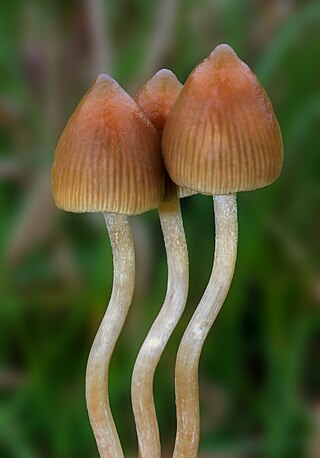
Psilocybe semilanceata, commonly known as the liberty cap, is a species of fungus which produces the psychoactive compounds psilocybin, psilocin and baeocystin. It is both one of the most widely distributed psilocybin mushrooms in nature, and one of the most potent. The mushrooms have a distinctive conical to bell-shaped cap, up to 2.5 cm (1 in) in diameter, with a small nipple-like protrusion on the top. They are yellow to brown, covered with radial grooves when moist, and fade to a lighter color as they mature. Their stipes tend to be slender and long, and the same color or slightly lighter than the cap. The gill attachment to the stipe is adnexed, and they are initially cream-colored before tinting purple to black as the spores mature. The spores are dark purplish-brown in mass, ellipsoid in shape, and measure 10.5–15 by 6.5–8.5 micrometres.

Psathyrella is a large genus of about 400 species, and is similar to the genera Coprinellus, Coprinopsis, Coprinus and Panaeolus, usually with a thin cap and white or yellowish white hollow stem. The caps do not self digest as do those of Coprinellus and Coprinopsis. Some also have brown spores rather than black. These fungi are often drab-colored, difficult to identify, and all members are considered inedible or worthless and so they are often overlooked. However they are quite common and can occur at times when there are few other mushrooms to be seen. The first report of a gilled mushroom fruiting underwater is Psathyrella aquatica.

Hygrophoropsis aurantiaca, commonly known as the false chanterelle, is a species of fungus in the family Hygrophoropsidaceae. It is found across several continents, growing in woodland and heathland, and sometimes on woodchips used in gardening and landscaping. Fruit bodies (mushrooms) are yellow–orange, with a funnel-shaped cap up to 8 cm across that has a felt-like surface. The thin, often forked gills on the underside of the cap run partway down the length of the otherwise smooth stipe. Reports on the mushroom's edibility vary – it is considered poisonous, but has historically been eaten in parts of Europe and the Americas.

Gyromitra infula, commonly known as the hooded false morel or the elfin saddle, is a fungus in the family Helvellaceae. The dark reddish-brown caps of the fruit bodies develop a characteristic saddle-shape in maturity, and the ends of both saddle lobes are drawn out to sharp tips that project above the level of the fruit body. The stipe is white or flushed pale brown, smooth on the outside, but hollow with some chambers inside. It is found in the Northern Hemisphere, usually in the late summer and autumn, growing on rotting wood or on hard packed ground. G. infula is considered inedible as it contains the toxic compound gyromitrin which, when metabolized by the body, is converted into monomethylhydrazine, a component of some rocket fuels. The toxin may be removed by thorough cooking. Gyromitra fungi are included in the informal category "false morels".

Agaricus albolutescens, commonly known as the amber-staining agaricus, is a moderate-sized, stocky-statured mushroom with a pleasant odor; it bruises slowly but persistently yellow.
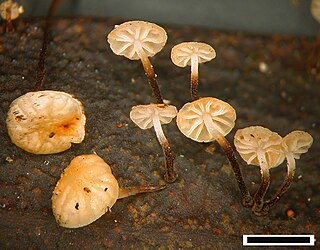
Gloiocephala is a genus of fungi in the family Physalacriaceae. The genus is widespread, though mainly known from tropical and sub-tropical areas, and contains about 30 species.
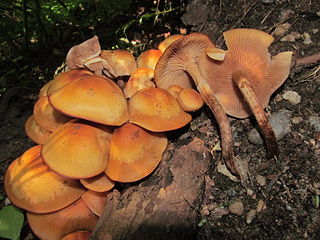
Armillaria nabsnona is a species of fungus in the family Physalacriaceae. The species is found in the west coast of North America, Hawaii, and Japan, where it grows on decaying hardwoods, particularly species of alder. Its fruit bodies have convex to flattened orange-brown caps up to 7 cm in diameter, brown stipes, and whitish to pinkish-tan gills.

Tulosesus impatiens is a species of fungus in the family Psathyrellaceae. First described in 1821, it has been classified variously in the genera Psathyrella, Pseudocoprinus, Coprinarius, and Coprinus, before molecular phylogenetics reaffirmed it as a Coprinellus species in 2001. The fungus is found in North America and Europe, where the mushrooms grow on the ground in deciduous forests. The fruit bodies have buff caps that are up to 4 cm (1.6 in) in diameter, held by slender whitish stems that can be up to 10 cm (3.9 in) tall. Several other Coprinopsis species that resemble C. impatiens may be distinguished by differences in appearance, habit, or spore morphology.

Mycena stylobates, commonly known as the bulbous bonnet, is a species of inedible mushroom in the family Mycenaceae. Found in North America and Europe, it produces small whitish to gray fruit bodies with bell-shaped caps that are up to 15 mm (0.6 in) in diameter. The distinguishing characteristic of the mushroom is the fragile stipe, which is seated on a flat disk marked with distinct grooves, and fringed with a row of bristles. The mushrooms grow in small troops on leaves and other debris of deciduous and coniferous trees. The mushroom's spores are white in deposit, smooth, and ellipsoid-shaped with dimensions of 6–10 by 3.5–4.5 μm. In the development of the fruit body, the preliminary stipe and cap structures appear at the same time within the primordium, and hyphae originating from the stipe form a cover over the developing structures. The mycelia of the mushroom is believed to have bioluminescent properties.

Agaricus hondensis, commonly known as the felt-ringed agaricus, is a species of fungus in the family Agaricaceae. The species was officially described in 1912 by mycologist William Alphonso Murrill, along with three other Agaricus species that have since been placed in synonymy with A. hondensis. Found in the Pacific Northwest region of North America, A. hondensis fruits in the fall under conifers or in mixed forests.
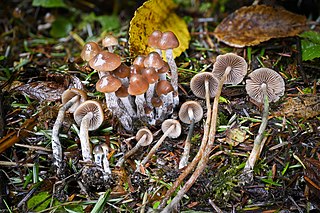
Psilocybe pelliculosa is a species of fungus in the family Hymenogastraceae. The fruit bodies, or mushrooms, have a conical brownish cap up to 2 cm in diameter atop a slender stem up to 8 cm long. It has a white partial veil that does not leave a ring on the stem. American mycologist Alexander H. Smith first described the species in 1937 as a member of the genus known today as Psathyrella; it was transferred to Psilocybe by Rolf Singer in 1958.

Mycena aurantiomarginata, commonly known as the golden-edge bonnet, is a species of agaric fungus in the family Mycenaceae. First formally described in 1803, it was given its current name in 1872. Widely distributed, it is common in Europe and North America, and has also been collected in North Africa, Central America, and Japan. The fungus is saprobic, and produces fruit bodies (mushrooms) that grow on the floor of coniferous forests. The mushrooms have a bell-shaped to conical cap up to 2 cm in diameter, set atop a slender stipe up to 6 cm long with yellow to orange hairs at the base. The fungus is named after its characteristic bright orange gill edges. A microscopic characteristic is the club-shaped cystidia that are covered with numerous spiky projections, resembling a mace. The edibility of the mushroom has not been determined. M. aurantiomarginata can be distinguished from similar Mycena species by differences in size, color, and substrate. A 2010 publication reported the discovery and characterization of a novel pigment named mycenaaurin A, isolated from the mushroom. The pigment is responsible for its color, and it has antibiotic activity that may function to prevent certain bacteria from growing on the mushroom.
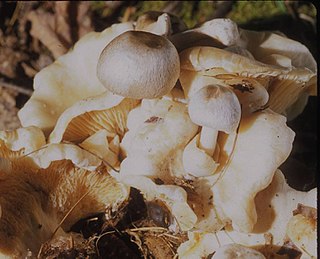
Volvariella surrecta, commonly known as the piggyback rosegill, is an agaric fungus in the family Pluteaceae. Although rare, the species is widely distributed, having been reported from Asia, North America, Northern Africa, Europe, and New Zealand. The fungus grows as a parasite on the fruit bodies of other gilled mushrooms, usually Clitocybe nebularis. V. surrecta mushrooms have white or greyish silky-hairy caps up to 8 cm (3.1 in) in diameter, and white gills that turns pink in maturity. The stipe, also white, is up to 9 cm (3.5 in) long, and has a sack-like volva at its base.

Phylloporus arenicola is a species of bolete mushroom in the family Boletaceae. It is found in the Pacific Northwest region of western North America, where it grows in sand dunes in a mycorrhizal association with pine trees. It is one of only three North American Boletaceae species that occur in coastal sand dunes.

Tricholoma vernaticum is an agaric fungus of the genus Tricholoma native to the Pacific Northwest region of the United States. The fungus was originally described in 1976 as a species of Armillaria when that genus was more inclusive; it received its current name twenty years later. The stout fruit bodies (mushrooms) have moist white to grayish caps, a membranous ring on the stipe, and an odor resembling cucumbers. Mycorrhizal with conifers, the fungus fruits in the spring or early summer, with its mushrooms appearing on the ground singly or in groups at high elevations, often at the edge of melting snowbanks. The edibility of the mushroom is unknown, but it has a strong unpleasant odor and a mealy taste.

Pholiota nubigena, commonly known as the gastroid pholiota or the bubble gum fungus, is a species of secotioid fungus in the family Strophariaceae. It is found in mountainous areas of the western United States, where it grows on rotting conifer wood, often fir logs. It fruits in spring, often under snow, and early summer toward the end of the snowmelt period in high mountain forests. Fruit bodies appear similar to unopened mushrooms, measuring 1–4 centimetres tall with 1–2.4 cm diameter caps that are whitish to brownish. They have a short but distinct whitish stipe that extend through the internal spore mass (gleba) of the fruit body into the cap. The gleba consists of irregular chambers made of contorted gills that are brownish in color. A whitish, cottony partial veil is present in young specimens, but it often disappears in age and does not leave a ring on the stipe.

Hygrophorus caeruleus is a rare species of agaric fungus in the family Hygrophoraceae. Found in the western United States, the mushroom is characterized by its stout fruit body including blue-tinted cap margin and stipe, blue-grey to bluish green gills, and odor of rancid meal.

Imleria badia, commonly known as the bay bolete, is an edible, pored mushroom found in Eurasia and North America, where it grows in coniferous or mixed woods on the ground or on decaying tree stumps, sometimes in prolific numbers. Both the common and scientific names refer to the bay- or chestnut-coloured cap, which is almost spherical in young specimens before broadening and flattening out to a diameter up to 15 cm (6 in). On the cap underside are small yellowish pores that turn dull blue-grey when bruised. The smooth, cylindrical stipe, measuring 4–9 cm long by 1–2 cm thick, is coloured like the cap, but paler. Some varieties have been described from eastern North America, differing from the main type in both macroscopic and microscopic morphology.

Oenanthe aquatica, fine-leaved water-dropwort, is an aquatic flowering plant in the carrot family. It is widely distributed from the Atlantic coast of Europe to central Asia.




















